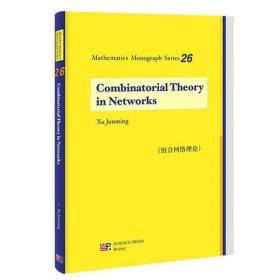
组合网络理论(英文版)
¥ 68 5.3折 ¥ 128 全新
仅1件
北京朝阳
认证卖家担保交易快速发货售后保障
作者徐俊明
出版社科学出版社
出版时间2013-03
版次1
装帧精装
上书时间2024-03-05
- 在售商品 暂无
- 平均发货时间 15小时
- 好评率 暂无
- 店主推荐
- 最新上架
商品详情
- 品相描述:全新
图书标准信息
- 作者 徐俊明
- 出版社 科学出版社
- 出版时间 2013-03
- 版次 1
- ISBN 9787030364784
- 定价 128.00元
- 装帧 精装
- 开本 16开
- 纸张 胶版纸
- 页数 409页
- 字数 400千字
- 【内容简介】
-
This book provides the most basic combinatorial problems and well-established theory in design and analysis of the topological structure of interconnection networks in the graph-theoretic language.It covers the basic methods of network design,several well-known networks such as hypercubes,de Bruijn digraphs,Kautz digraphs,double loop,and the newest parameters to measure performance of networks such as forwarding indices of a routing,Menger number,Rabin number,fault-tolerant diameter,wide-diameter,generalized dominating number,and restricted connectivity.It will be of significant interest to researchers and practitioners working in design and analysis of networks,particularly to undergraduates and postgraduates specializing in computer science and applied mathematics.
Xu Junming is a Professor at School of Mathematical Sciences,the University of Science and Technology of China(USTC),a fellow of Operations Research Society of China,and Commission on Combinatorics and Graph Theory in China.His research interest is combinatorics and graph theory,in particular,combinatorial problems of interconnection networks,has published more than 200 research papers. - 【目录】
-
Preface
Part Ⅰ Networks and Graphs
Chapter 1 Fundamentals of Networks and Graphs
1.1 Graphs and Networks
1.2 Basic Concepts and Notations
1.3 Trees and Planar Graphs
1.4 Transmission Delay and Diameter
1.5 Fault Tolerance and Connectivity
1.6 Embedding and Routings
1.7 Basic Principles of Network Design
Exercises
Chapter 2 Symmetry of Graphs or Networks
2.1 Fundamentals on Groups
2.2 Vertex-Transitive Graphs
2.3 Edge-Transitive Graphs
2.4 Atoms of Graphs
2.5 Connectivity of Transitive Graphs
Exercises
Part Ⅱ Basic Methods of Network Designs
Chapter 3 Line Graphical Methods
3.1 Line Graphs and Basic Properties
3.2 Basic Properties of Line Digraphs
3.3 Iterated Line Graphs
3.4 Connectivity of Line Graphs
Exercises
Chapter 4 Cayley Methods
4.1 Cayley Graphs
4.2 Transitivity of Cayley Graphs
4.3 Atoms and Connectivity of Cayley Graphs
4.4 Vertex-Transitive Graphs with Prime Order
Exercises
Chapter 5 Cartesian Product Methods
5.1 Cartesian Product of Graphs
5.2 Diameter and Connectivity
5.3 Other Properties of Cartesian Products
5.4 Generalized Cartesian Products
Exercises
Chapter 6 Basic Problems in Optimal Designs
6.1 Undirected(d,k)-Graph Problems
6.2 Directed(d,k)-Graph Problems
6.3 Relations between Diameter and Connectivity
Exercises
Part Ⅲ Well-Known Topologies of Networks
Chapter 7 Hypercube Networks
7.1 Definitions and Basic Properties
7.2 Gray Codes and Cycles
7.3 Lengths of Paths
7.4 Embedding Problems
7.5 Generalized Hypercubes
7.6 Some Variations of Hypercubes
Exercises
Chapter 8 De Bruijn Networks
8.1 Definitions and Basic Properties
8.2 Uniqueness of Shortest Paths
8.3 Generalized de Bruijn Digraphs
8.4 Comparison with Hypercubes
Exercises
Chapter 9 Kautz Networks
9.1 Definitions and Basic Properties
9.2 Generalized Kautz Digraphs
9.3 Connectivity of Generalized Kautz Digraphs
Exercises
Chapter 10 Double Loop Networks
10.1 Double Loop Networks
10.2 L-Tiles in the Plane
10.3 L-Tiles and Double Loop Networks
10.4 Design of Optimal Double Loop Networks
10.5 Basic Properties of Circulant Networks
Exercises
Chapter 11 Topologies of Other Networks
11.1 Mesh Networks and Grid Networks
11.2 Pyramid Networks
11.3 Cube-Connected Cycles
11.4 Butterfly Networks
11.5 Bene* Networks
11.6 Ω Networks
11.7 Shuffle-Exchange Networks
Exercises
Part Ⅳ Fault-Tolerant Analysis of Networks
Chapter 12 Routings in Networks
12.1 Forwarding Index of Routing
12.2 Edge-Forwarding Index of Routing
12.3 Forwarding Indices of Some Graphs
12.4 Delay of Fault-Tolerant Routing
Exercises
Chapter 13 Fault-Tolerant Diameters in Networks
13.1 Diameters of Altered Graphs
13.2 Edge Fault-Tolerant Diameters
13.3 Relations between Two Diameters
13.4 Vertex Fault-Tolerant Diameters
13.5 Fault-Tolerant Diameter of Product Graphs
13.6 Fault-Tolerant Diameters of Some Networks
Exercises
Chapter 14 Menger-Type Problems in Parallel Systems
14.1 Menger-Type Problems
14.2 Bounded Menger Number and Connectivity
14.3 Bounded Edge-Connectivity
14.4 Rabin Numbers of Networks
Exercises
Chapter 15 Wide-Diameters of Networks
15.1 Wide-Diameter and Basic Results
15.2 Wide-Diameter of Regular Graphs
15.3 Wide-Diameter of Cartesian Products
15.4 Wide-Diameter and Independence Number
15.5 Wide-Diameter and Fault-Tolerant Diameter
15.6 Wide-Diameters of Some Networks
Exercises
Chapter 16 Generalized Independence and Domination Numbers
16.1 Generalized Independence Numbers
16.2 Generalized Domination Numbers
16.3 Distance Independence and Domination
Exercises
Chapter 17 Restricted Fault-Tolerance of Networks
17.1 Restricted Connectivity and Diameter
17.2 Restricted Edge-Connectivity
17.3 Restricted Edge-Atoms
17.4 Results on Transitive Graphs
17.5 Super Connectivity of Networks
17.6 Super Edge-Connectivity of Networks
17.7 Super Connectivity of Line Graphs
17.8 Connectivity Restricted by Degree-Conditions
17.9 Connectivity Restricted by Order-Conditions
17.10 Restricted Connectivity of Some Networks
Exercises
Bibliography
A List of Notations
Index
点击展开
点击收起
相关推荐
— 没有更多了 —









![毛主席论无产阶级专政下继续革命 红塑皮软精装[19张毛彩图、2张毛林彩图、1张林题词]](https://www0.kfzimg.com/20110528/2100557/18530PnYtiM_s.jpg)
![毛主席论无产阶级专政下继续革命 红塑皮软精装[19张毛彩图、2张毛林彩图、2张林题词]](https://www0.kfzimg.com/20110601/2100557/18530RaTqSP_s.jpg)
















以下为对购买帮助不大的评价